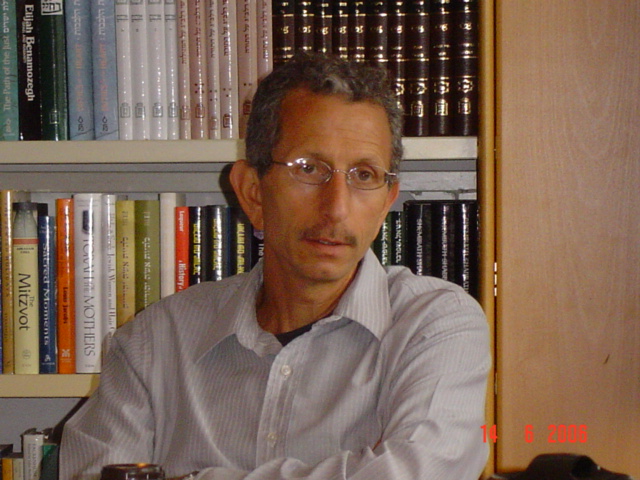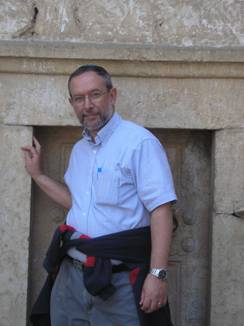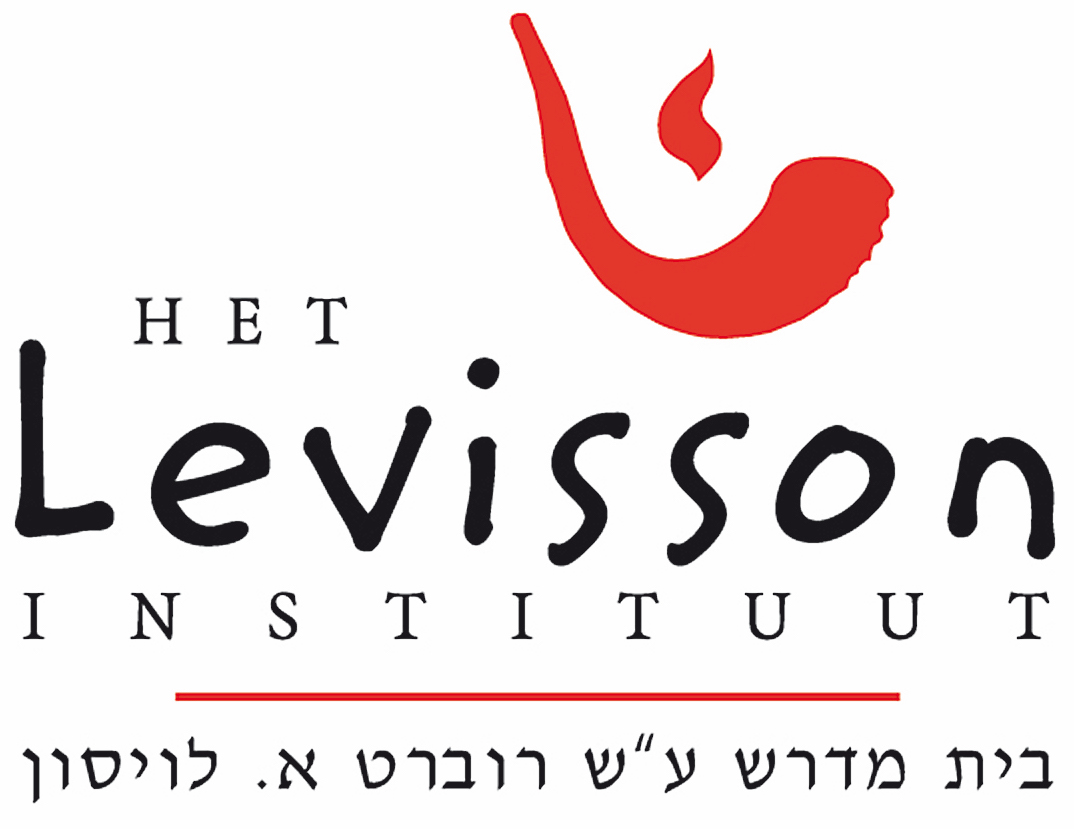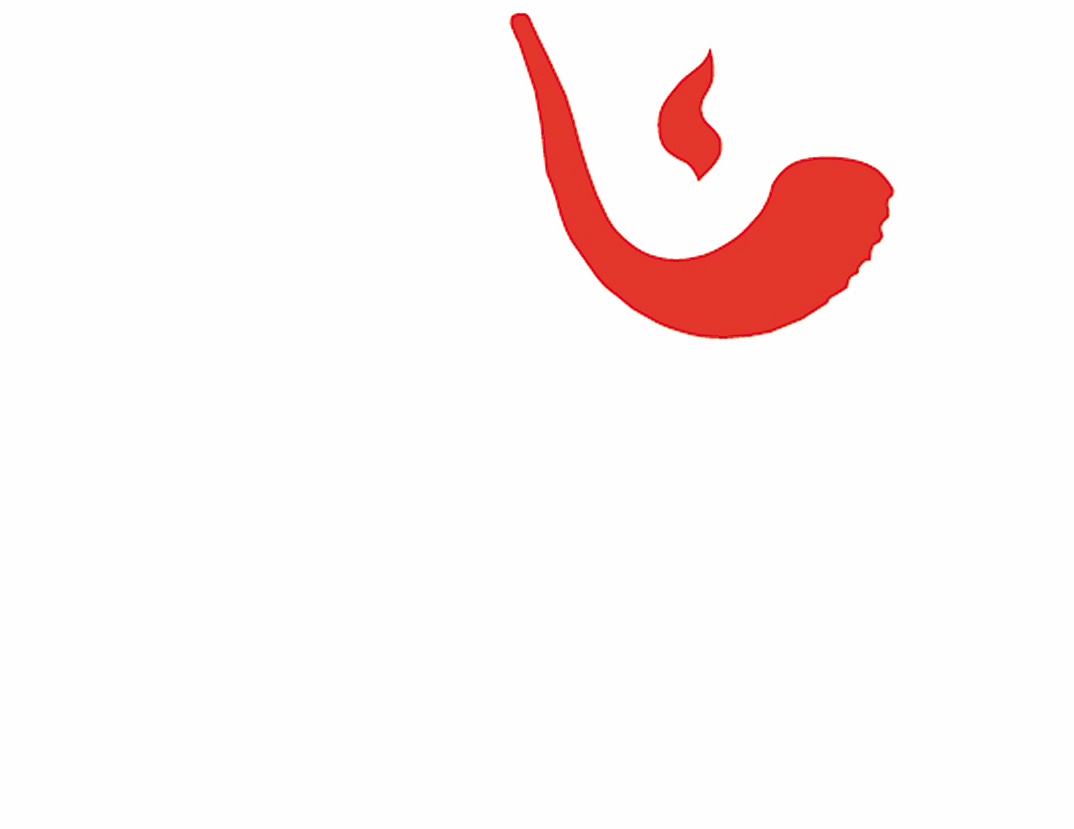Reuven Firestone

Op 18 juni 2006 hield Reuven Firestone voor het Levisson Instituut een lezing getiteld If there is only one God, why are there so many monotheisms?
Lees de volledige tekst van zijn lezing.
All believers in one God derive their spiritual existence from the same deity, whatever that deity is called. Monotheism began as a unifying system. And yet from the earliest annals of religious history, we observe monotheists arguing, fighting and warring with one another over which understanding of God and the divine will is really true. Such observation almost requires us to ask: Is there something about the nature of monotheism that encourages conflict?
ORIGINS
If we want to know about monotheism, we need to begin at the beginning, and the story begins with the emergence of monotheism. It seems to have taken monotheism quite a while to emerge as a belief system in the long intellectual history of humanity. There is still some controversy among scholars over exactly when, where and how monotheism emerged. I intend to explore the change in thinking about divinity, from a multiplicity of Gods to one God, a change that current Biblical scholarship places sometime around the 6th century BCE or later. While my approach certainly includes theological issues, I want to be clear that I am not interested here in the theological problematic of “truth” in relation to God. I am working now as a historian, not a theologian, so in theory, I could arrive at the same conclusion whether I am a Jew, a Christian, a Muslim or none of the above.
There is wide agreement among biblical scholars and historians of religion that the Israelites did not suddenly come upon the notion of the One God. It was, rather, a process.
And in fact, Israel may not have been the only community working on the issue of monotheism. There is that pesky Egyptian pharaoh, Akhenaton whose reign seems to reflect, at the very least, a kind of henotheism in which only one God is worshipped while not denying the existence of other Gods. Some consider him to have been a true monotheist. But his theology did not catch on. It died with him.
Joshua Schwartz
 Prof. dr. Joshua Schwartz is verbonden aan het Department of Land of Israel Studies and Archeology aan de Bar Ilan Universiteit in Ramat Gan. Lees zijn biografie.
Prof. dr. Joshua Schwartz is verbonden aan het Department of Land of Israel Studies and Archeology aan de Bar Ilan Universiteit in Ramat Gan. Lees zijn biografie.
Bij de opening van het Academische Jaar 2006-2007 van het Levisson Instituut, op 6 september 2006, hield Joshua Schwartz een lezing getiteld Broken beds and chairs in Mishnah Kelim.
Deze wat gepopulariseerde lezing is in 2006 ook gepubliceerd (pdf) onder de titel Reduce, Reuse and Recycle, Prolegomena on Breakage and Repair in Ancient Jewish Society: Broken Beds and Chairs in Mishnah Kelim.
Introductie
There are many ways for a historian to write about a society, and the tools at his or her disposal are manifold and varied. The materials that we have chosen are somewhat unusual; the building blocks of our reconstruction are waste and rubbish. We intend to examine aspects of ancient Jewish history and Jewish society based on its debris and in particular, debris that is not discarded, but rather used, sometimes repaired and occasionally recycled into secondary use. In other words, we will study used and reused garbage. Litter and trash are our primary sources. Garbage is a mirror on our society. What you are is often what you break, throw out or do not want and what people say and what garbage says is sometimes divergent.
Theoretically, garbage is such a pervasive element in our society (after all, garbage is connected to almost every aspect of human activity, and waste is so central to our lives) that one might imagine that the study of waste would have attracted much academic interest. This, however, is certainly not the case and even modern garbology deals, for the most part, only with modern society. This conundrum is largely what differentiates garbology from archaeology. Archaeology usually deals with imperishables while garbology focuses on perishables and in particular the attempt to make the perishable imperishable through recycling. The archaeologist rarely has a chance to study the perishables of the ancient world; they have long disappeared. The recycled material of the ancient world is for the most part unidentifiable. This helps explain why garbology has rarely been used in the study of the ancient world.
We seek to somewhat circumvent this problem by making use of a rather radical strategy. While not disregarding the minimal relevant archaeological data, our primary source material will be literary, for the most part rabbinic, in particular the Mishnah and Tosefta of Tractate Kelim, which deals with issues of purity and impurity in relation to utensils. While utensils are mentioned throughout rabbinic literature, the format of Kelim, as we shall see, provides detailed information, albeit secondary and often tangential, about broken utensils and their repair or lack thereof and occasionally of their secondary recycled use.
Vader-Joden
Een seminar om te leren, te luisteren en na te denken
In joodse kringen wordt veel gesproken over de positie van personen met een joodse vader en een niet-joodse moeder. Zijn ze wel joods of niet? Horen ze wel tot de joodse gemeenschap of niet? En als ze niet automatisch als joods worden aangemerkt, maar het wel willen zijn, hoe gaat dat dan, en bij wie?
De meningen zijn zeer verdeeld, velen voelen zich gekwetst, maar wat zijn de feiten? Hoe is deze moeizame situatie ontstaan? En, hoe gaan verschillende instanties en mensen ermee om?
Op zondag 9 april 2006 werd door het Menasseh ben Israel Instituut en het Levisson Instituut een seminar georganiseerd waarin deze problematiek vanuit verschillende academische invalshoeken werd belicht in een openbaar seminar voor iedereen die in deze materie is geïnteresseerd en/of erbij betrokken is.
LEZINGEN EN VOORDRACHTEN
Het programma bestond uit drie gedeelten:
1. De lezingen
Prof dr. Irene Zwiep: Introductie
Luister (mp3) deel 1 deel 2
Tamarah Benima (publiciste): De historische context, voor en na 1945
Lees de tekst (pdf) en luister (mp3)
Dr. Marlene de Vries (Universiteit van Amsterdam): Vader-Joden en hun band met het Jodendom: de cijfers
Lees de tekst (pdf) en luister (mp3)
Prof. dr. Piet van der Horst (Universiteit Utrecht): Het ontstaan van de halachische traditie
Lees de tekst (pdf) en luister (mp3)
Prof. dr. Herman van Praag (Acad. Ziekenhuis Maastricht, Stichting Psychiatrie en Religie): Het psychologische aspect – de vorming van de persoonlijke identiteit
Lees de tekst (pdf) en luister (mp3)
2. Een aantal Joodse organisaties gaf inzicht in het toelatingsbeleid en beantwoordde de volgende vragen:
- Wat is uw toelatingsbeleid?
- Hoe bent u tot dit beleid gekomen?
- Wat zijn uw eraringen hiermee?
JONAG / Spreker Corinne Falch Luister (mp3)
CiJO / Spreker Nathan Bouscher Lees (pdf) en luister (mp3)
Moos! / Spreker Barbara Tanenbaum Lees (pdf) en luister (mp3)
WIZO / Spreker Joyce Numann-Durlacher Lees (pdf) en luister (mp3)
Beit Ha’Chidush / Spreker Renée Citroen Lees (pdf) en luister (mp3)
Joods Maatschappelijk Werk / Spreker Hans Vuijsje Luister (mp3)
LJG Amsterdam / Spreker rabbijn Menno ten Brink Luister (mp3)
3. Persoonlijke verhalen
Ewoud Sanders Luister (mp3)
Aatje Huyser-Frijda Lees (pdf) en luister (mp3)
TL Lees (pdf)
THE STATUS OF CHILDREN OF MIXED MARRIAGES
The Status of Children of Mixed Marriages: Voor de veelal verkeerd geciteerde beslissing van de Amerikaanse Reformbeweging van 15 maart 1983 met betrekking op mensen met één joodse ouder (Patrilineal Decision).
Resolution on Patrilineal Descent
Resolution Adopted on March 15, 1983 by the Central Conference of American Rabbis.
The purpose of this document is to establish the Jewish status of the children of mixed marriages in the Reform Jewish community of North America.One of the most pressing human issues for the North American Jewish community is mixed marriage, with all its attendant implications. For our purpose, mixed marriage is defined as a union between a Jew and a non-Jew. A non-Jew who joins the Jewish people through conversion is recognized as a Jew in every respect. We deal here only with the Jewish identity of children which one parent is Jewish and the other parent is non-Jewish.This issue arises from the social forces set in motion by the Enlightenment and the Emancipation. They are the roots of our current struggle with mixed marriage. “Social change so drastic and far reaching could not but affect on several levels the psychology of being Jewish…. The result of Emancipation was to make Jewish identity a private commitment rather than a legal status, leaving it a complex mix of destiny and choice” (Robert Seltzer, Jewish People, Jewish Thought, p. 544). Since the Napoleonic Assembly of Notables of 1806, the Jewish community has struggled with the tension between modernity and tradition. This tension is now a major challenge, and it is within this specific context that the Reform Movement chooses to respond. Wherever there is ground to do so, our response seeks to establish Jewish identity of the children of mixed marriages.According to the Halacha as interpreted by traditional Jews over many centuries, the offspring of a Jewish mother and a non-Jewish father is recognized as a Jew, while the offspring of a non-Jewish mother and a Jewish father is considered a non-Jew. To become a Jew, the child of a non-Jewish mother and a Jewish father must undergo conversion.As a Reform community, the process of determining an appropriate response has taken us to an examination of the tradition, our own earlier responses, and the most current considerations. In doing so, we seek to be sensitive to the human dimensions of this issue.
Both the Biblical and the Rabbinical traditions take for granted that ordinarily the paternal line is decisive in the tracing of descent within the Jewish people. The Biblical genealogies in Genesis and elsewhere in the Bible attest to this point. In intertribal marriage in ancient Israel, paternal descent was decisive. Numbers 1:2, etc., says: “By their families, by their fathers’ houses” (lemishpechotam leveit avotam), which for the Rabbis means, “The line [literally: ‘family’] of the father is recognized; the line of the mother is not” (Mishpachat av keruya mishpacha; mishpachat em einah keruya mishpacha; Bava Batra 109b, Yevamot 54b; cf. Yad, Nachalot 1.6).
In the Rabbinic tradition, this tradition remains in force. The offspring of a male Kohen who marries a Levite or Israelite is considered a Kohen, and the child of an Israelite who marries a Kohenet is an Israelite. Thus: yichus, lineage, regards the male line as absolutely dominant. This ruling is stated succinctly in Mishna Kiddushin 3.12 that when kiddushin (marriage) is licit and no transgression (ein avera is involved, the line follows the father. Furthermore, the most important parental responsibility to teach Torah rested with the father (Kiddushin 29a; cf. Shulchan Aruch, Yoreh De-a 245.1).
When, in the tradition, the marriage was considered not to be licit, the child of that marriage followed the status of the mother (Mishna Kiddushin 3.12, havalad kemotah). The decision of our ancestors thus to link the child inseparably to the mother, which makes the child of a Jewish mother Jewish and the child of a nonJewish mother non-Jewish, regardless of the father, was based upon the fact that the woman with her child had no recourse but to return to her own people. A Jewish woman could not marry a non-Jewish man (cf. Shulchan Aruch, Even Ha-ezer 4.19, la tafsei kiddushin). A Jewish man could not marry a non-Jewish woman. The only recourse in Rabbinic law for the woman in either case was to return to her own community and people.Since Emancipation, Jews have faced the problem of mixed marriage and the status of the offspring of mixed marriage. The Reform Movement responded to the issue. In 1947 the CCAR adopted a proposal made by the Committee on Mixed Marriage and Intermarriage:With regard to infants, the declaration of the parents to raise them as Jews shall be deemed sufficient for conversion. This could apply, for example, to adopted children. This decision is in line with the traditional procedure in which, according to the Talmud, the parents bring young children (the Talmud speaks of children earlier than the age of three) to be converted, and the Talmud comments that although an infant cannot give its consent, it is permissible to benefit somebody without his consent (or presence). On the same page the Talmud also speaks of a father bringing his children for conversion, and says that the children will be satisfied with the action of their father. If the parents therefore will make a declaration to the rabbi that it is their intention to raise the child as a Jew, the child may, for the sake of impressive formality, be recorded in the Cradle-Roll of the religious school and thus be considered converted.Children of religious school age should likewise not be required to undergo a special ceremony of conversion but should receive instruction as regular students in the school. The ceremony of Confirmation at the end of the school course shall be considered in lieu of a conversion ceremony.Children older than confirmation age should not be converted without their own consent. The Talmudic law likewise gives the child who is converted in infancy by the court the right to reject the conversion when it becomes of religious age. Therefore the child above religious school age, if he or she consents sincerely to conversion, should receive regular instruction for that purpose and be converted in the regular conversion ceremony. (CCAR Yearbook, Vol. 57)This issue was again addressed in the 1961 edition of the Rabbi’s Manual:Jewish law recognizes a person as Jewish if his mother was Jewish, even though the father was not a Jew. One born of such mixed parentage may be admitted to membership in the synagogue and enter into a marital relationship with a Jew, provided he has not been reared in or formally admitted into some other faith. The child of a Jewish father and a non- Jewish mother, accoridng to traditional law, is a Gentile; such a person would have to be formally converted in order to marry a Jew or become a synagogue member.Reform Judaism, however, accepts such a child as Jewish without a formal conversion, if he attends a Jewish school and follows a course of studies leading to Confirmation. Such procedure is regarded as sufficient evidence that the parents and the child himself intend that he shall live as a Jew. (Rabbi’s Manual, p. 112)We face today an unprecedented situation due to the changed conditions in which decisions concerning the status of the child of a mixed marrige are to be made. There are tens of thousands of mixed marriages. In a vast majority of these cases the non-Jewish extended family is a functioning part of the child’s world, and may be decisive in shaping the life of the child. It can no longer be assumed a priori, therefore, that the child of a Jewish mother will be Jewish any more than that the child of a non-Jewish mother will not be.This leads us to the conclusion that the same requirements must be applied to establish the status of a child of a mixed marriage, regardless of whether the mother or the father is Jewish.Therefore:The Central Conference of American Rabbis declares that the child of one Jewish parent is under the presumption of Jewish descent. This presumption of the Jewish status of the offspring of any mixed marriage is to be established through appropriate and timely public and formal acts of identification with the Jewish faith and people. The performance of these mitzvot serves to commit those who participate in them, both parent and child, to Jewish life.Depending on circumstances,1 mitzvot leading toward a positive and exclusive Jewish identity will include entry into the covenant, acquisition of a Hebrew name, Torah study, Bar/Bat Mitzvah, and Kabbalat Torah (Confirmation).2 For those beyond childhood claiming Jewish identity, other public acts or declarations may be added or substituted after consultation with their rabbi.
____________________________________________________
Notes
1According to the age or setting, parents should consult a rabbi to determine the specific mitzvot which are necessary.
2 A full description of these and other mitzvot can be found in Sha’arei Mitzvah

